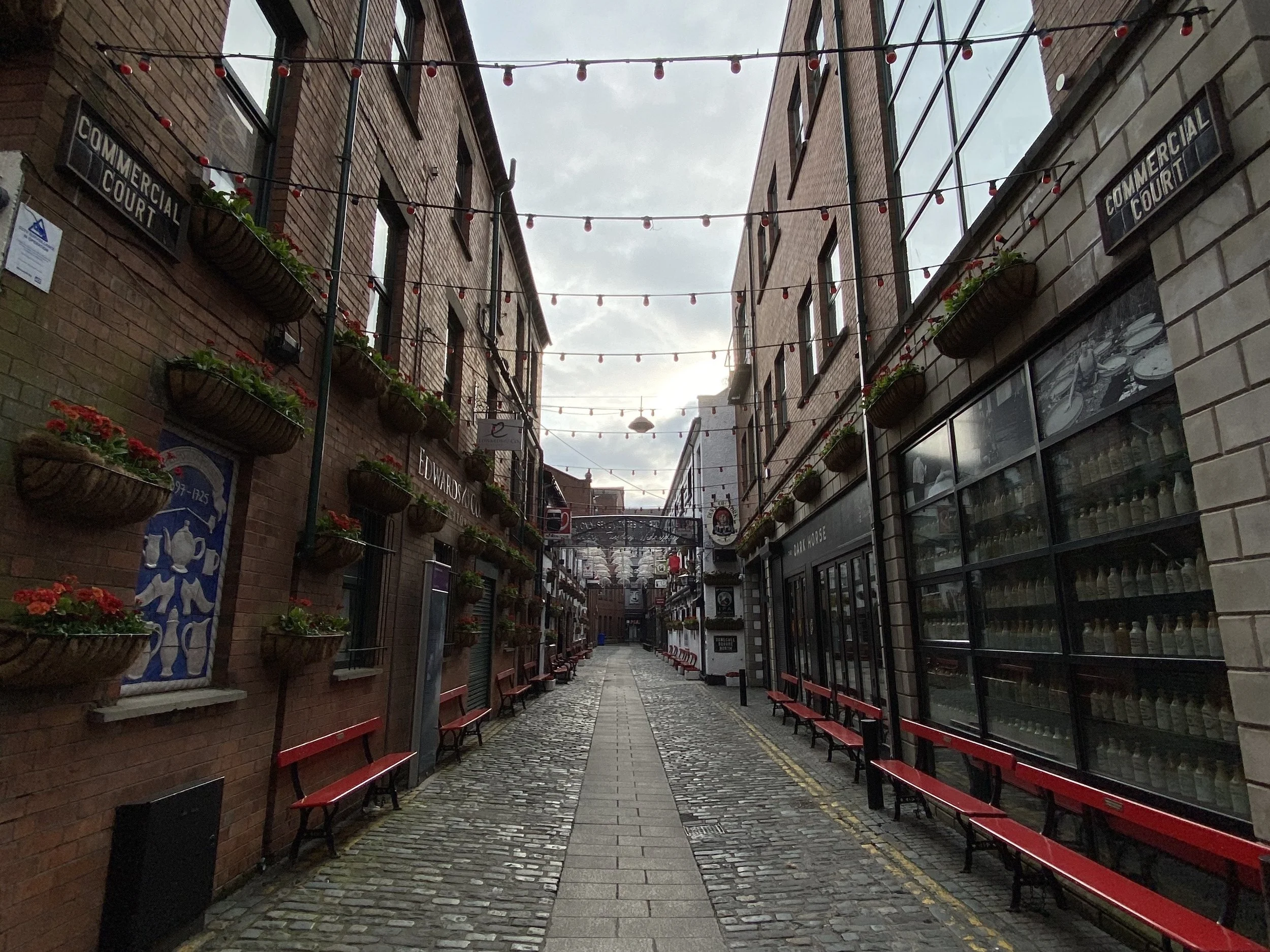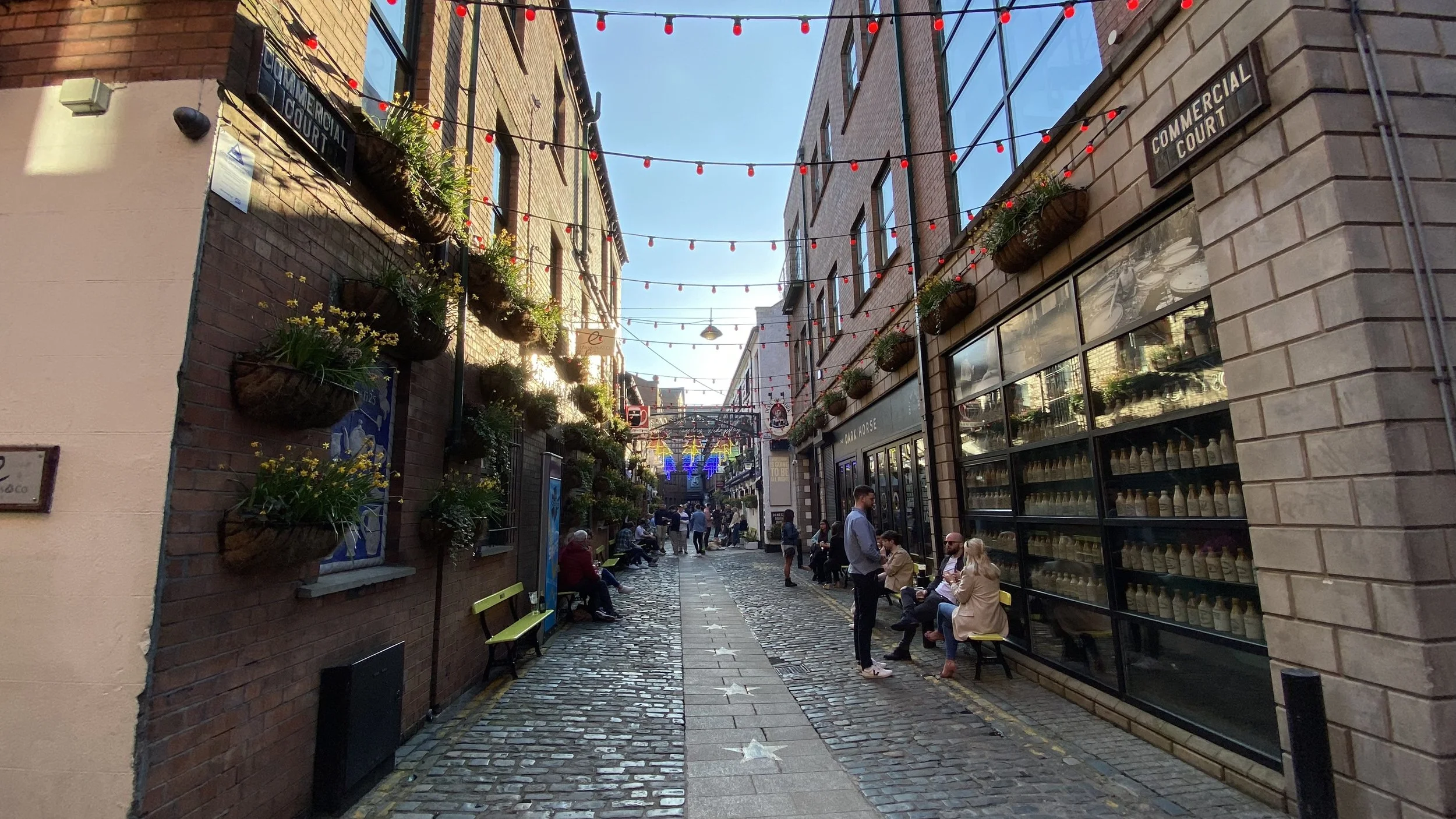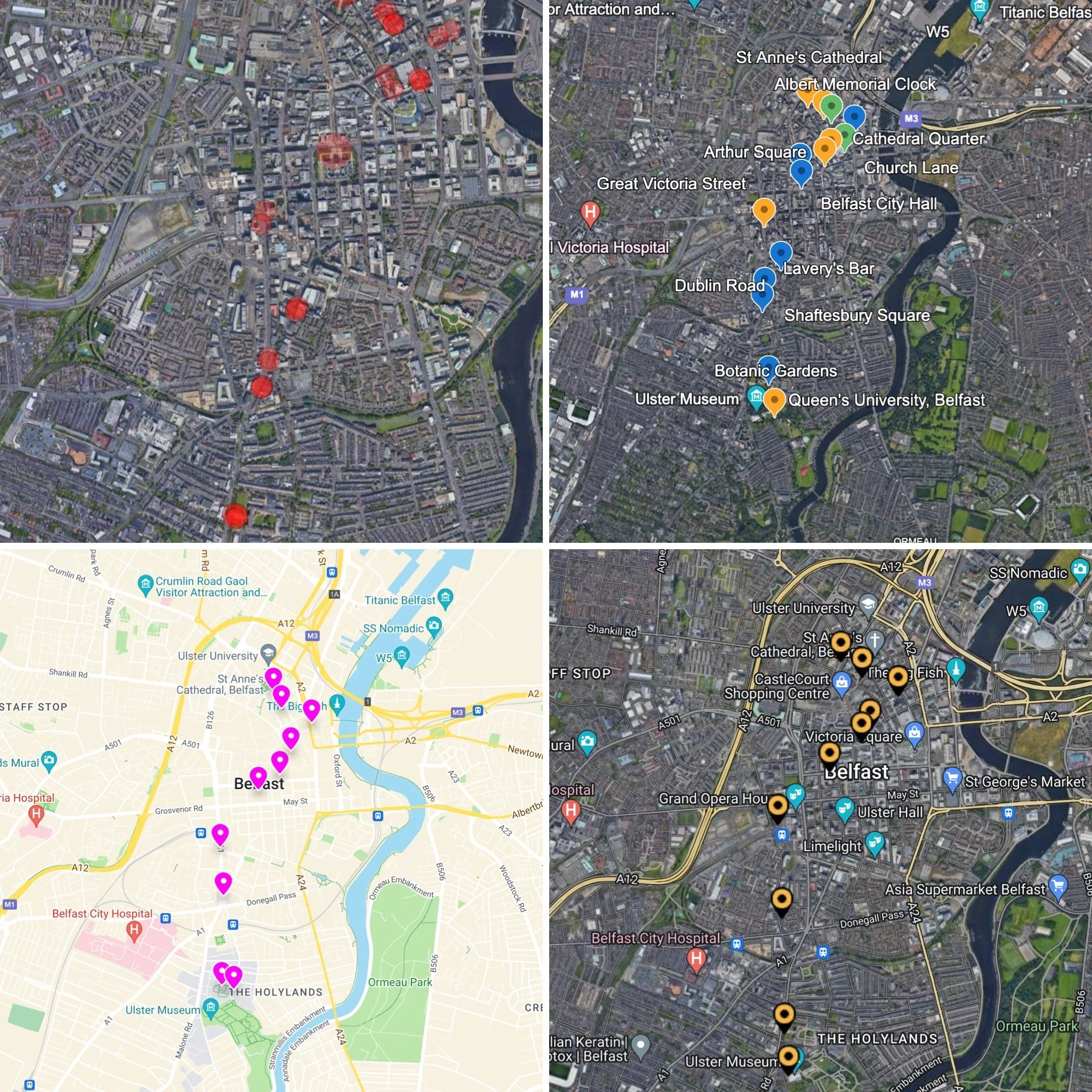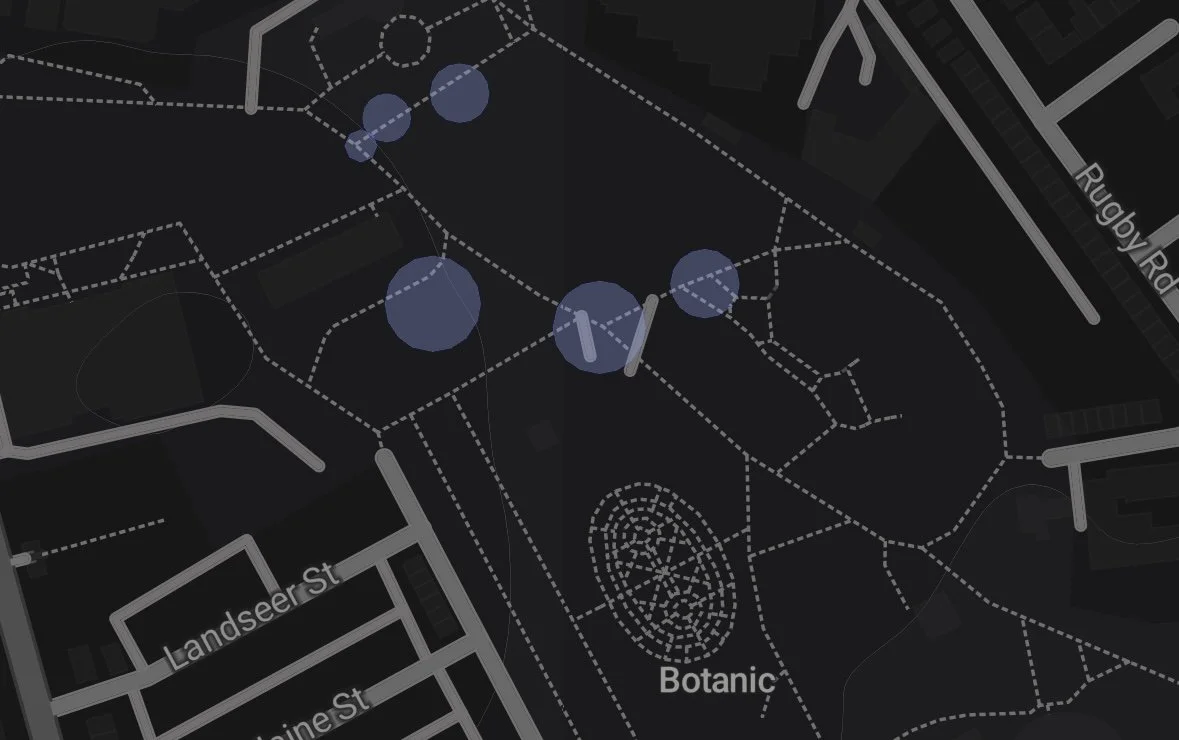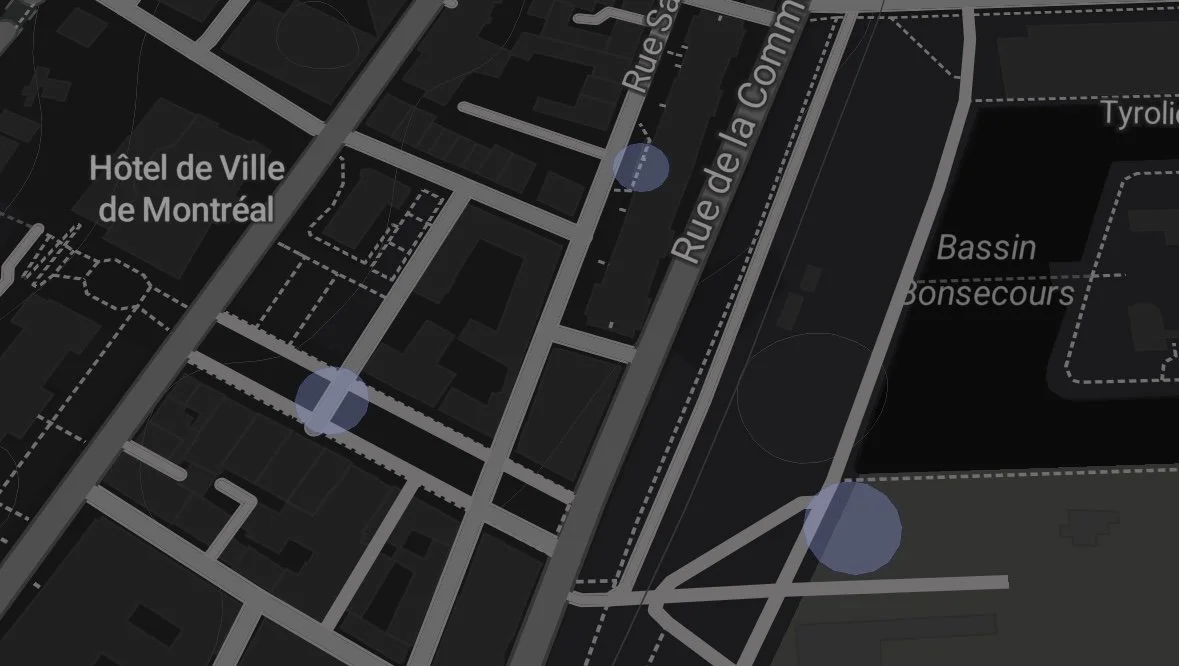Creative Mapping from the Sounding Covid-19 Repository
Dr Georgios Varoutsos
Coronavirus Notice at Botanic Gardens
At the beginning of the Covid-19 lockdowns in Belfast, Northern Ireland, on March 23, 2020, my approach to understanding the unfolding events was to use my one daily activity - as defined by the Stay-At-Home orders [1] - and walk around my permitted distance from home, listening to the impacts of restrictions and the city’s aural conditions. This is a process known as soundwalking, where the listener actively focuses on the sounds within their environment and uses the sensory experience of sound to inform present-day understandings.[2] During the initial days of the lockdown, I realized that I should document my experiences using field recording techniques that would comply with the restrictions. The purpose of this documentation was to capture what was audible, and represent the various effects of Covid on daily life, and the resulting changes through sound and field recording practices.
First Soundwalk and Field Recording for Sounding Covid-19 on March 27, 2020
On March 27, 2020, I began the first phase of recording my soundwalks, which included recording various public urban places in Belfast chosen from the VisitBelfast tourist map.[3] Factors guiding my choices included their significance in historical, community, and urban relationships, accessibility to residents and tourists once lockdowns were lifted, my personal safety in open spaces, recording different sites alone, and distance from home. It is essential to note that there were additional constraints to these recordings:
(1) audio recordings were only five-minute durations due to rules implying that no person may remain in a static position for prolonged periods or else face penalties
(2) in post-production, these audio recordings were reduced to two-minute soundscape compositions by applying Truax techniques of time-compression which allow highlighting salient features similar and in addition to my limited recording times, also remove damaging audio properties such as clipping or wind that affected the quality of full recordings.[4]
Over two years, the research focused primarily on Belfast’s varied lockdown stages – and one lockdown period in Montreal, Canada - all of which aided in creating the Sounding Covid-19 Repository.[5] Divided into four parts: Belfast’s Lockdowns (1-3 in 2020-2021), Exit Strategies (Summers 2020 and 2021), Lifted Restrictions (2022), and Montreal’s lockdown visit in 2020-2021. The repository contains 91 soundscape compositions produced from across 27 locations.
Here is a timeline demonstration from the repository of one of the main sites, the Commercial Court in the Cathedral Quarter of Belfast. This is a popular destination for locals and tourists as it is a prominent location for daytime and night-time events, has rich aesthetics, and is near other main points within the city centre.
2020-03-27 Commercial Court – Lockdown 1.
2022-03-27 Commercial Court – Lifted Restrictions
The main objective of the repository was to create an audio timeline that allows users to compare restriction stages from across multiple field recording sessions conducted at the same sites during specific times and dates. This repository enables users to listen to the recordings and identify different patterns or changes in the sonic environment. By doing so, we can make the previously invisible impacts of government and health organisations’ advice audible and understand the types of impacts we faced during the pandemic. For example, we can analyse how the presence or absence of human-generated sounds affects the diverse relationships between nature, urban, and self or other humans. We can even observe new behaviours, such as adhering to social distancing rules, being formed and impacting sonic changes.
Furthermore, creating repositories of audio media has an exploratory aspect when considering sharing such media with others, demonstrating the active change in the repository’s nature from documentative to new forms of creative/research practice. This concept has been explored by looking at soundmaps, both online and on-site, to expand access and engagement to the repository. This allows novel ways to learn and consider alternative sensory perceptions when understanding the environment and events.
Repository to Soundmaps
Collage of Soundmaps highlighting Belfast contributions
Soundmaps, online or on-site, showcase sound experiences and events to inform us like visual or textual information. Encouraging people from diverse backgrounds to consider sound documentation provides alternative perspectives and highlights sound’s critical importance as a valuable form of information. Holanda, Rebelo, and Paz discuss how initiatives such as the Belfast Sound Map[6] promote audio-submission participation and supportive contextual information, such as other media or texts, to generate new knowledge about events or experiences.[7] Since 2020, the Sounding Covid-19 Repository has extended its usability by sharing it onto various soundmaps, including Udo Noll – Radio Aporee – Soundscapes in the Pandemic13,[8] Pete Stollery - Covid-19 Sound Map,[9] Stefania Zardini Lacedelli - Science + Media Museum Present: Sounds of my quarantine,[10] and Stuart Fowkes - Cities and Memory: #StayHomeSounds.[11] The repository responds or contributes to specific initiatives, themes, or purposes of those individual soundmaps; therefore, at times, there are smaller or incomplete representations of the repository on these maps.
These contributions aimed to promote the accessibility of audio content with broader project goals, targeting specific themes and intentions of documented periods. As Droumeva mentions, new links opened with the opportunity to share recordings from moments within quarantine, regardless of where a listener may access the material.[12] Online soundmaps allow people to engage with site-related content and to listen or compare differences between their own experiences and/or learn about the conditions of another place. This helps in both cases; either having prior knowledge of a place, where one can reflect on their previous experiences, or by encouraging learning about a new place they have not visited. These types of platforms provide a 2D map, where the contributor uses geo-located points to place sound recordings on the map and any additional information for others to access audio-focused information about specific events related to the place. Each of my soundmap contributions aims to reflect the recorded locations of the field recordings in the soundscape compositions. It becomes a new canvas of learning and highlights the importance of sound as a possibility to contain vital information from which to learn, inform new areas of research or practice, and enlarge relationships between researchers, artists, hobbyists, or listeners within a global community.
“Echo Points” from Botanic Gardens in Belfast
“Echo Points" from Montreal
Simultaneously, consideration for on-site learning was developed through the design and creation of soundwalk activities using Josh Kopeček’s Echoes Soundwalking App, in both Belfast[13] and Montreal.[14] “Echo points” in the app are locations where the material automatically starts to play once you are inside the designated circumference of these geo-located points. The points followed the recorded locations for people to visit and listen through the different stages of Covid-19, contrasting with a real-time listening experience to raise awareness of using audio documentation for any noticeable changes or impressions gained from listening across time. It aims to engage the participants to learn more about their urban places and how sound is a component of their experiences, understanding how we can be informed by or through sound, and how having this mode of dissemination creates a real-time/historical comparative property.
Sounding Belfast During Covid-19 - Walking Tour part of NI Science Festival 2023
Initially, these activities aimed to allow individual listeners to have complete freedom to listen to as many “Echo points” as possible in a semi-guided manner. This approach encouraged anyone to take directions without predetermined guidance when exploring the map. In 2023, this concept expanded to include a group soundwalking activity as part of the Northern Ireland Science Festival in Belfast. During the soundwalk, I guided the participants, highlighted particular sounds or sequences of audio events, shared my experiences creating the repository and discussed the times within lockdowns. The aim was to enable participants to share their own stories or insights gained from listening to the audio material and to promote an open dialogue amongst the group. We explored listening, aural history and preservation, and how we could learn by incorporating audio as valuable as any other sensory experience.
Future Thinking
There is a need to reflect on the mentioned contributions and consider how information sharing can be improved to accommodate future use cases. During the NI Science Festival, the group engaged in soundwalking, and it was observed that such events are open to people of all abilities. The main concern is to build inclusive experiences for people to participate in such events, engage with the audio material, and build relationships within communities and organisations that can bring about positive changes for our environment and lives. The Sounding Covid-19 Repository reflects not only the changes in sound during the pandemic but also highlights the status of our well-being, the types of care we receive during a crisis, and the need for cities to develop more green spaces for the well-being of its residents rather than solely for commercial purposes. The recordings show that during the height of lockdowns, most public places were empty, and people sought refuge in green spaces wherever they could access them, leading to overcrowding in these areas, contrary to the restrictions’ aim.
The repository’s modular design allows for diverse and innovative learning experiences, as demonstrated by the soundmaps available online or on-site. The repository encourages users to create their own learning experiences based on the information's accessibility. This resource goes beyond being an archive or library tool. It offers a range of Covid-19 audio sources that can be used to create various experiential learning opportunities, such as musical compositions or other artistic practices. By using sound mapping, the audio repository is made accessible to people either at its origin or through remote locations, allowing them to establish a new learning relationship with the recordings. This approach promotes the acquisition of contextual information that is embedded within the recordings, highlighting the difference between facilitated walks that encourage interactive discussions and engagements with the soundscape compositions and individual exploration of the audio repository.
There are many things to consider regarding the impact of sound on documenting our experiences and how we can use audio recordings to create different types of engagement. It is essential to consider certain factors when recording audio, such as the context in which the recordings will be made. It is important to not only determine why the recordings are being made and how they will be used in online or on-site sound maps for diverse learning experiences but also to plan activities that can be safely conducted together in the event of future pandemics. Adaptable formats for cultural engagement, such as socially distanced walking tours or virtual community gatherings, could provide opportunities for accessible participation during crises. Additionally, it is crucial to consider innovative preservation methods for recorded sounds to ensure the continued documentation of human history, even in challenging circumstances. This will help to maximise the impact and value of these or other recordings.
In conclusion, it is crucial to acknowledge the diverse ways in which different groups interpret and connect with sound. Sound can carry various meanings and significance across cultures, communities, and individuals, shaping their understanding and interaction with the surrounding world. The sound repository, accessible online and on-site, has facilitated engagement, revealing discernible patterns among participants. Listening to these sounds and juxtaposing them with contemporary experiences provides an innovative lens through which to perceive history. Nonetheless, it's important to note that this experience may vary for remote users.
Sound can offer an alternative perspective on history, fostering a novel comprehension that engages the auditory senses. This form of knowledge sparks internal reflections and serves as a catalyst for dialogue and discourse. Through conversations with individuals from diverse backgrounds or sound experiences, I have realised that sound can deepen our understanding of human experiences, inviting us to engage with the ever-changing world in new ways. This newfound appreciation for sound has forged connections - both with our environment and one another - creating a space where sound becomes a vehicle for exchanging and expanding our collective wisdom.
Author
Dr. Georgios Varoutsos
SARC: Centre for Interdiciplinary Research in Sound and Music
Queen’s University Belfast
Notes
[1] Cabinet Office. 2020. ‘Staying at Home and Away from Others (Social Distancing)’. https://assets.publishing.service.gov.uk/government/uploads/system/uploads/attachment_data/file/883116/Staying_at_home_and_away_from_others__social_distancing_.pdf.
[2] Smolicki, Jacek, and Tim Shaw. 2021. ‘Thinking Eye, Wandering Ear’. Journal of Landscape Architecture 16 (3): 76–81. https://doi.org/10.1080/18626033.2021.2046787.
[3] VisitBelfast. 2019. ‘Belfast Visitor Map 2019’. Visit Belfast (blog). Accessed 24 March 2020. https://s3a.visitbelfast.com/app/uploads/2019/09/VB_VisitorMap.pdf.
[4] Truax, Barry. 2022. ‘Speech, Music, Soundscape and Listening: Interdisciplinary Explorations’. Interdisciplinary Science Reviews 47 (2): 279–93. https://doi.org/10.1080/03080188.2022.2035103.
[5] Varoutsos, Georgios. 2023. ‘Sounding Covid-19 Repository’. Zenodo. https://doi.org/10.5281/zenodo.8245034.
[6] http://belfastsoundmap.org/
Designed by Pedro Rebelo, Rui Chaves, Matilde Meireles and Aoghus McEvoy in collaboration with Max Stein. Maintained by the Sonic Arts Research Centre, Queen’s University Belfast. (© Pedro Rebelo, Rui Chaves, Matilde Meireles, Aoghus McEvoy and Max Stein)
[7] Holanda, Claudia, Pedro Rebelo, and André Paz. 2016. ‘Soundmaps as IDocs? Modes of Interactivity for Storytelling with Sound’. Leonardo Music Journal 26: 80–82.
[8] https://aporee.org/maps/work/projects.php?project=corona
[9]https://earth.google.com/web/@7.15136362,26.56433629,617.82610191a,14171672.1012581d,30.00089482y,0h,0t,0r/data=MikKJwolCiExN0MwN3o5Y1JIOV8ycjRXOE5IYmlYSkt0cDVFMHBCcl8gAToDCgEw?authuser=0
[10] https://padlet.com/platformmuseum/sounds-of-my-quarantine-q9unei4soco98xu8
[11] https://citiesandmemory.com/covid19-sounds/
[12] Droumeva, Milena. 2021. ‘Remixing the Pandemic, One Sound at a Time Cities and Memory, #StayHomeSounds’. Sound Studies 7 (1): 147–50. https://doi.org/10.1080/20551940.2021.1875291.
[13] https://explore.echoes.xyz/collections/QZQN9a10To92iDoM
[14] https://explore.echoes.xyz/collections/Q6FztVnFMhtOzHoO


